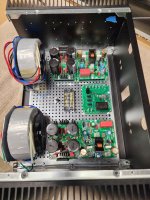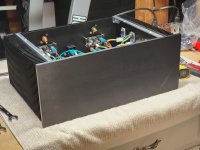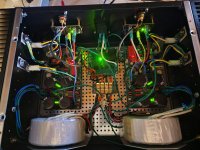Good morning fellow forum members,
Progress report on my FH9HVX build. Progress has been agonizingly slow. As I alluded to in my last post, I junked the original toroid brackets. They were too flimsy. I decided to go with the L-300 brackets that Bloqhed recommended. Although it was a bit of a wait for them to arrive, they turned out to be the clear ticket for my vertical installation. Fastened to the base plate with 1/4" bolts and lock nuts, those toroids aren't going anywhere.
I planned on moving the amp boards up to the heat sinks but that didn't go so well. I was trying to tap the mounting holes for the standoffs when I realized my tap had too much of a taper. It was bottoming out before it was creating any useful threads. Obviously, I can only drill the holes a few mm deep without drilling through the other side. After deliberating whether to look for/order/wait to arrive/ another tap, I returned to my original plan of trying to make it all fit on the baseplate. Some clearances may be tight, but I think I can make it work. For what it's worth I have a good supply of high-quality insulated female spade connectors for those connections.
Sounds like the RTR SSR speaker protection boards from XRK's shop should arrive just in time for me. I hope to begin making basic connections soon.
There you have the latest. Thanks everyone. Dave M.
Progress report on my FH9HVX build. Progress has been agonizingly slow. As I alluded to in my last post, I junked the original toroid brackets. They were too flimsy. I decided to go with the L-300 brackets that Bloqhed recommended. Although it was a bit of a wait for them to arrive, they turned out to be the clear ticket for my vertical installation. Fastened to the base plate with 1/4" bolts and lock nuts, those toroids aren't going anywhere.
I planned on moving the amp boards up to the heat sinks but that didn't go so well. I was trying to tap the mounting holes for the standoffs when I realized my tap had too much of a taper. It was bottoming out before it was creating any useful threads. Obviously, I can only drill the holes a few mm deep without drilling through the other side. After deliberating whether to look for/order/wait to arrive/ another tap, I returned to my original plan of trying to make it all fit on the baseplate. Some clearances may be tight, but I think I can make it work. For what it's worth I have a good supply of high-quality insulated female spade connectors for those connections.
Sounds like the RTR SSR speaker protection boards from XRK's shop should arrive just in time for me. I hope to begin making basic connections soon.
There you have the latest. Thanks everyone. Dave M.
Attachments
Another FH9HVX is born!
It took some time to assemble my project in the enclosure with much putting together and taking apart again on this, my first high power amplifier build. It was quite a relief to see all of the LED's light up when I powered up the variac.
Bias is currently running about 26 mV with about -8.5 mV offset. (No variac, straight into mains outlet). I am currently playing music with a FiiO digital music player for testing purposes. I will offer some listening impressions in the near future after I nail down some minor issues. So far it sounds awesome. Stay tuned.
It took some time to assemble my project in the enclosure with much putting together and taking apart again on this, my first high power amplifier build. It was quite a relief to see all of the LED's light up when I powered up the variac.
Bias is currently running about 26 mV with about -8.5 mV offset. (No variac, straight into mains outlet). I am currently playing music with a FiiO digital music player for testing purposes. I will offer some listening impressions in the near future after I nail down some minor issues. So far it sounds awesome. Stay tuned.
Attachments
Hello forum members,
Well so far, so good. My FH9HVX continues to pump out the music, although I'm lacking a proper preamp.
I was quite pleased with a fairly trouble-free start-up. Initially, I was unable to obtain any bias voltage reading on the right channel. This turned out to be a poor connection between the board and the voltage multiplier connection. Easily repaired. The only thing I hope to add at this point is an amber power LED. I'm hoping I can access DC voltage from one of the positive rails and use a resistor to bring the voltage down to the proper level for power.
The sound? Excellent. I really am impressed with the clarity and separation between instruments in some of the studio recordings I've listened to. I can't wait to connect a quality preamplifier to this amp.
Speaking of preamps, I would like to construct one for this amplifier. Any suggestions? I was thinking of the ACP+ or Wayne's linestage.
It's too bad that I missed the group buy on the Yarra chassis' some months ago. I would have liked to build a Yarra with Hakuin daughter boards. However, I don't think I can justify the cost of a one-off machined enclosure. Any thoughts on a preamp that would be a good fit for the FH9?
My project wouldn't be successful without the enormous amount of assistance and technical support from other members. So here's a big Thank You to XRK971, PoseidansVoice, Bloqhed, Vunce, RickRay and many others who were helpful during my build.
I'll be around. I've got the bug now!🙂
Respectfully, Dave M.
Well so far, so good. My FH9HVX continues to pump out the music, although I'm lacking a proper preamp.
I was quite pleased with a fairly trouble-free start-up. Initially, I was unable to obtain any bias voltage reading on the right channel. This turned out to be a poor connection between the board and the voltage multiplier connection. Easily repaired. The only thing I hope to add at this point is an amber power LED. I'm hoping I can access DC voltage from one of the positive rails and use a resistor to bring the voltage down to the proper level for power.
The sound? Excellent. I really am impressed with the clarity and separation between instruments in some of the studio recordings I've listened to. I can't wait to connect a quality preamplifier to this amp.
Speaking of preamps, I would like to construct one for this amplifier. Any suggestions? I was thinking of the ACP+ or Wayne's linestage.
It's too bad that I missed the group buy on the Yarra chassis' some months ago. I would have liked to build a Yarra with Hakuin daughter boards. However, I don't think I can justify the cost of a one-off machined enclosure. Any thoughts on a preamp that would be a good fit for the FH9?
My project wouldn't be successful without the enormous amount of assistance and technical support from other members. So here's a big Thank You to XRK971, PoseidansVoice, Bloqhed, Vunce, RickRay and many others who were helpful during my build.
I'll be around. I've got the bug now!🙂
Respectfully, Dave M.
Hi Dave,
Congrats on your new amp! Glad that it is playing music and sounding great. The skills and lessons learned from this build will carry you through to the next one and it gets easier and better.
Regarding preamps, the FH9HVX has 29dB gain so no preamp is needed for gain. Even a basic DAC with volume control or a phone with 3.5mm to RCA output can drive it.
The Yarra is an excellent preamp and very versatile as you can change out preamp
cores to change the sound signature.
May I suggest the Aksa Lender preamp or the DCA? Both have a nice SE Class A harmonic profile. The DCA more so than Aksa Lender which was designed to drive 0dB gain amps like the F4 or MoFo. The DCA is an easy build and very simple to operate and startup. Enjoy the sound!
Cheers,
X
Congrats on your new amp! Glad that it is playing music and sounding great. The skills and lessons learned from this build will carry you through to the next one and it gets easier and better.
Regarding preamps, the FH9HVX has 29dB gain so no preamp is needed for gain. Even a basic DAC with volume control or a phone with 3.5mm to RCA output can drive it.
The Yarra is an excellent preamp and very versatile as you can change out preamp
cores to change the sound signature.
May I suggest the Aksa Lender preamp or the DCA? Both have a nice SE Class A harmonic profile. The DCA more so than Aksa Lender which was designed to drive 0dB gain amps like the F4 or MoFo. The DCA is an easy build and very simple to operate and startup. Enjoy the sound!
Cheers,
X
I am ordering the parts to build this amp with the PREMIUM BOM.
FQA40N25 is in stock but FQA36P15 is out of stock at Mouser.
Is there any alternatives?
Should I order FQA36P15 on ebay?
FQA40N25 and FQA36P15 needs to be matched?
Any other parts to be matched?
BTW, I wonder why the output mosfet pair is FQA40N25 / FQA36P15 instead of FQA46N15 / FQA36P15.
Is FQA28N15 / FQA36P15 pair proper too?
FQA40N25 is in stock but FQA36P15 is out of stock at Mouser.
Is there any alternatives?
Should I order FQA36P15 on ebay?
FQA40N25 and FQA36P15 needs to be matched?
Any other parts to be matched?
BTW, I wonder why the output mosfet pair is FQA40N25 / FQA36P15 instead of FQA46N15 / FQA36P15.
Is FQA28N15 / FQA36P15 pair proper too?
Last edited:
X,
I received an order from Digikey of the FQA40N25 transistor. Part number is FQA40N25FS-ND. It’s described as “MOSFET N-CH 250V 40A TO3PN.”
When I plug it into my Mega328 tester it states that this is an “N-E-IGBT” device. The other transistor measures the same.
Why? Is it a mistake, dud or is the transistor tester unable to discern the differences between N-E-IGBT and N-ch MOSFET? It also says that the Rds = 0.0 ohms.
FWIW, I have another pair of FQA40N25’s that measure as N-ch MOSFETS (Rds = 0.8 ohms). Of course it has a different set of date codes than the ones that just arrived from Digikey.
This is an inexpensive transistor tester limited by the small currents it uses during biasing, so I have hope that’s where the issues lie.
Best,
Anand.
I received an order from Digikey of the FQA40N25 transistor. Part number is FQA40N25FS-ND. It’s described as “MOSFET N-CH 250V 40A TO3PN.”
When I plug it into my Mega328 tester it states that this is an “N-E-IGBT” device. The other transistor measures the same.
Why? Is it a mistake, dud or is the transistor tester unable to discern the differences between N-E-IGBT and N-ch MOSFET? It also says that the Rds = 0.0 ohms.
FWIW, I have another pair of FQA40N25’s that measure as N-ch MOSFETS (Rds = 0.8 ohms). Of course it has a different set of date codes than the ones that just arrived from Digikey.
This is an inexpensive transistor tester limited by the small currents it uses during biasing, so I have hope that’s where the issues lie.
Best,
Anand.
@Mark Johnson
Thanks for your input as always. I figure I should stop worrying and just put this transistor that is labeled as an N-ch MOSFET to service.
Best,
Anand.
Thanks for your input as always. I figure I should stop worrying and just put this transistor that is labeled as an N-ch MOSFET to service.
Best,
Anand.
@namghiwook
That’s correct, cathode (-) connects to R111. See schematic on 1st page of this thread.

Best,
Anand.
That’s correct, cathode (-) connects to R111. See schematic on 1st page of this thread.
Best,
Anand.
I agree that the cathode bar on that LED could be made more clear but use of schematic is also easy.
- Home
- Group Buys
- FH9HVX - Budget Conscious 100w Class AB for Lean Times
 ^^^
^^^



